|

|
Fujifilm must have been looking towards style conscious consumers when they designed the F402 because it is
endowed with more sex appeal than a digital camera really ought to have.
81% Rating: 
|
|
|
|
Home >
Reviews >
Digital Cameras >
FujiFilm FinePix F402 |
|
|
A closer look at the F402
The FinePix F402 measures just 3" x 2.7" x 0.9" in
size. The case is made from aluminum,
and with no large buttons or catches to stick out is fairly well protected in pockets and
bags from accidentally being turned on. Since the lens is recessed into the body of the
camera there is no need to go looking for a lens cap - it stows itself away once
the camera is turned off.
These photos of the F402 were taken with a FujiFilm
Finepix 4800Z which has a recessed lens as well, but since the lens is fixed
in place when it extends out of the camera it can be quite fragile
if the camera is rough handled. Speaking from past experience, and a $400
repair bill for my 4800Z, I'm glad to see Fujifilm adopt a floating
point lens with the F402.
What I mean by floating point is that once the lens extends out, as shown in the photo below, it
can move freely up and down. So for example, if the camera were
to be accidentally turned on inside a bag, between two heavy text books,
the lens wouldn't be crushed or gears damaged as in the case of
my ill fated 4800Z Finepix.
| The FujiFilm FinePix F402 |
|
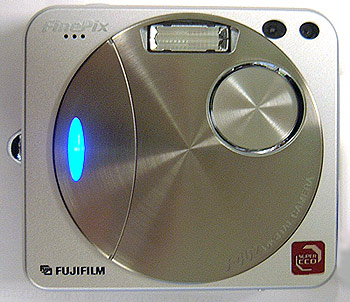 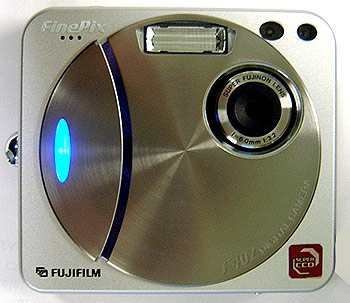
|
|
The camera is shown with its blue light on
for effect - when the F402 is charging the LED remains
lit, as it does for the first few seconds after being turned
on.
To turn on the Finepix F402, you pull back
on that little part of the metal circle with the blue light (this is
why we show the camera with that light on). It slides to the
left a few millimeters and the camera springs to life. To turn off
the camera, just push that portion of the circle back in. Below
the FinePix logo is the small mic for recording audio during short
films
The lens is a super fujinon 1:3.2, f=
6mm with a focal length of 1.6ft to infinity.
With macro turned on, focal length is 0.2ft to 2.1ft. The aperture is
F 3.2/8 and the optical viewfinder in the upper right hand corner is
pinhole sized, but clear. The flash is fixed and there are
no provisions for a hot shoe because of the size of the
camera.
|
|
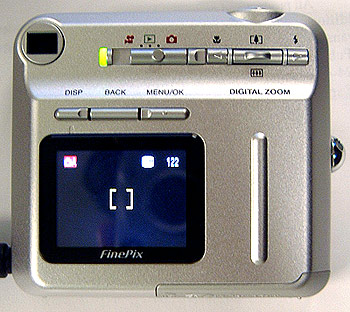
|
|
The rear of the FinePix F402 is well laid out,
and the controls are fairly intuitive. The tiny optical viewfinder is
useful in bright conditions when the LCD may become hard to see. Adjacent to
the green status LED (it glows orange when the camera is storing or
transferring data) is the mode button for "film - playback - photos." The macro
button is next in line followed by zoom control which does double duty as a cursor control.
Last but not least is the flash control button - enabling
you to turn on red-eye reduction, flash suppression, or other settings.
The 1.5" (110,000 pixel) TFT LCD viewfinder really offers a superb
display, rivaling the display quality of most current generation notebooks. The three
buttons on top of the LCD are for display controls, and OSD navigation.
|
|
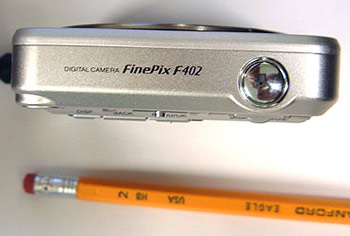
|
|
For comparisons sake, we took a picture of the top of the Finepix F402
adjacent to a standard pencil. The pencil measures about 8mm in
diameter, and the F402 is a little over 2.5X that much (23mm).
There is only one control on the top of the camera and that is the
shutter release. In the default setting the camera gives out an audible
beep when the shutter release is depressed half way for auto focusing. I'd
recommend turning that beep off because for some people it can sound like
the camera has taken a photo when in fact the shutter release wasn't
pressed far enough.
|
|
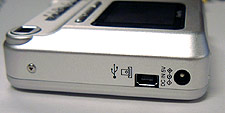
|
|
The bottom of the F402 is bare except for a cover which protects the battery and
flash memory storage compartment. On the left hand side we have a DC port
for the AC adaptor to plug into. An optional docking station will allow you to recharge
the camera battery, or the adaptor can just be plugged in here.
In either case, it takes approximately two hours to fully recharge the
3.7V 710mAh Lithium Ion battery pack.
The remaining port works as both the jack for the USB cable, and the socket
for when the camera is in the docking station. There is no
video out signal, but the camera can be used with Fujifilm's own
software package (PictureHello) for video conferencing.
|
|
|
|
|
